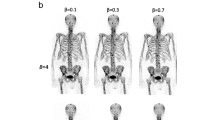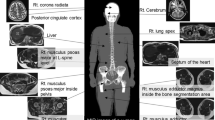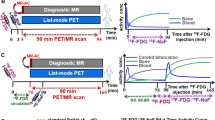Abstract
Purpose
The outcome of a detailed assessment of various strategies for atlas-based whole-body bone segmentation from magnetic resonance imaging (MRI) was exploited to select the optimal parameters and setting, with the aim of proposing a novel one-registration multi-atlas (ORMA) pseudo-CT generation approach.
Methods
The proposed approach consists of only one online registration between the target and reference images, regardless of the number of atlas images (N), while for the remaining atlas images, the pre-computed transformation matrices to the reference image are used to align them to the target image. The performance characteristics of the proposed method were evaluated and compared with conventional atlas-based attenuation map generation strategies (direct registration of the entire atlas images followed by voxel-wise weighting (VWW) and arithmetic averaging atlas fusion). To this end, four different positron emission tomography (PET) attenuation maps were generated via arithmetic averaging and VWW scheme using both direct registration and ORMA approaches as well as the 3-class attenuation map obtained from the Philips Ingenuity TF PET/MRI scanner commonly used in the clinical setting. The evaluation was performed based on the accuracy of extracted whole-body bones by the different attenuation maps and by quantitative analysis of resulting PET images compared to CT-based attenuation-corrected PET images serving as reference.
Results
The comparison of validation metrics regarding the accuracy of extracted bone using the different techniques demonstrated the superiority of the VWW atlas fusion algorithm achieving a Dice similarity measure of 0.82 ± 0.04 compared to arithmetic averaging atlas fusion (0.60 ± 0.02), which uses conventional direct registration. Application of the ORMA approach modestly compromised the accuracy, yielding a Dice similarity measure of 0.76 ± 0.05 for ORMA-VWW and 0.55 ± 0.03 for ORMA-averaging. The results of quantitative PET analysis followed the same trend with less significant differences in terms of SUV bias, whereas massive improvements were observed compared to PET images corrected for attenuation using the 3-class attenuation map. The maximum absolute bias achieved by VWW and VWW-ORMA methods was 06.4 ± 5.5 in the lung and 07.9 ± 4.8 in the bone, respectively.
Conclusions
The proposed algorithm is capable of generating decent attenuation maps. The quantitative analysis revealed a good correlation between PET images corrected for attenuation using the proposed pseudo-CT generation approach and the corresponding CT images. The computational time is reduced by a factor of 1/N at the expense of a modest decrease in quantitative accuracy, thus allowing us to achieve a reasonable compromise between computing time and quantitative performance.








Similar content being viewed by others
References
Judenhofer MS, Wehrl HF, Newport DF, Catana C, Siegel SB, Becker M, et al. Simultaneous PET-MRI: a new approach for functional and morphological imaging. Nat Med. 2008;14:459–65.
Zaidi H, Del Guerra A. An outlook on future design of hybrid PET/MRI systems. Med Phys. 2011;38:5667–89.
Wiesmuller M, Quick HH, Navalpakkam B, Lell MM, Uder M, Ritt P, et al. Comparison of lesion detection and quantitation of tracer uptake between PET from a simultaneously acquiring whole-body PET/MR hybrid scanner and PET from PET/CT. Eur J Nucl Med Mol Imaging. 2013;40:12–21.
Becker M, Zaidi H. Imaging in head and neck squamous cell carcinoma: the potential role of PET/MRI. Br J Radiol. 2014;87:20130677.
Spick C, Herrmann K, Czernin J. 18F-FDG PET/CT and PET/MRI perform equally well in cancer patients: evidence from studies in more than 2300 patients. J Nucl Med. 2016;57:420–30.
Bezrukov I, Mantlik F, Schmidt H, Scholkopf B, Pichler BJ. MR-based PET attenuation correction for PET/MR imaging. Semin Nucl Med. 2013;43:45–59.
Mehranian A, Arabi H, Zaidi H. Vision 20/20: magnetic resonance imaging-guided attenuation correction in PET/MRI: challenges, solutions, and opportunities. Med Phys. 2016;43:1130–55.
Zaidi H, Montandon M-L, Slosman DO. Magnetic resonance imaging-guided attenuation and scatter corrections in three-dimensional brain positron emission tomography. Med Phys. 2003;30:937–48.
Martinez-Moller A, Souvatzoglou M, Delso G, Bundschuh RA, Chefd’hotel C, Ziegler SI, et al. Tissue classification as a potential approach for attenuation correction in whole-body PET/MRI: evaluation with PET/CT data. J Nucl Med. 2009;50:520–6.
Schulz V, Torres-Espallardo I, Renisch S, Hu Z, Ojha N, Börnert P, et al. Automatic, three-segment, MR-based attenuation correction for whole-body PET/MR data. Eur J Nucl Med Mol Imaging. 2011;38:138–52.
Montandon M-L, Zaidi H. Atlas-guided non-uniform attenuation correction in cerebral 3D PET imaging. Neuroimage. 2005;25:278–86.
Hofmann M, Bezrukov I, Mantlik F, Aschoff P, Steinke F, Beyer T, et al. MRI-based attenuation correction for whole-body PET/MRI: quantitative evaluation of segmentation- and Atlas-based methods. J Nucl Med. 2011;52:1392–9.
Arabi H, Zaidi H. Magnetic resonance imaging-guided attenuation correction in whole-body PET/MRI using a sorted atlas approach. Med Image Anal. 2016;31:1–15.
Keereman V, Fierens Y, Broux T, De Deene Y, Lonneux M, Vandenberghe S. MRI-based attenuation correction for PET/MRI using ultrashort echo time sequences. J Nucl Med. 2010;51:812–8.
Berker Y, Franke J, Salomon A, Palmowski M, Donker HC, Temur Y, et al. MRI-based attenuation correction for hybrid PET/MRI systems: a 4-class tissue segmentation technique using a combined Ultrashort-Echo-Time/Dixon MRI sequence. J Nucl Med. 2012;53:796–804.
Delso G, Wiesinger F, Sacolick L, Kaushik S, Shanbhag D, Hullner M, et al. Clinical evaluation of zero echo time MRI for the segmentation of the skull. J Nucl Med. 2015;56:417–22.
Rezaei A, Defrise M, Bal G, Michel C, Conti M, Watson C, et al. Simultaneous reconstruction of activity and attenuation in time-of-flight PET. IEEE Trans Med Imag. 2012;31:2224–33.
Mehranian A, Zaidi H. Joint estimation of activity and attenuation in whole-body TOF PET/MRI using constrained Gaussian mixture models. IEEE Trans Med Imaging. 2015;34:1808–21.
Izquierdo-Garcia D, Hansen AE, Forster S, Benoit D, Schachoff S, Furst S, et al. An SPM8-based approach for attenuation correction combining segmentation and nonrigid template formation: application to simultaneous PET/MR brain imaging. J Nucl Med. 2014;55:1825–30.
Schreibmann E, Nye JA, Schuster DM, Martin DR, Votaw J, Fox T. MR-based attenuation correction for hybrid PET-MR brain imaging systems using deformable image registration. Med Phys. 2010;37:2101–9.
Fei B, Yang X, Nye JA, Aarsvold JN, Raghunath N, Cervo M, et al. MRPET quantification tools: registration, segmentation, classification, and MR-based attenuation correction. Med Phys. 2012;39:6443–54.
Hofmann M, Steinke F, Scheel V, Charpiat G, Farquhar J, Aschoff P, et al. MRI-based attenuation correction for PET/MRI: a novel approach combining pattern recognition and Atlas registration. J Nucl Med. 2008;49:1875–83.
Malone IB, Ansorge RE, Williams GB, Nestor PJ, Carpenter TA, Fryer TD. Attenuation correction methods suitable for brain imaging with a PET/MRI scanner: a comparison of tissue atlas and template attenuation map approaches. J Nucl Med. 2011;52:1142–9.
Burgos N, Cardoso M, Thielemans K, Modat M, Schott J, Duncan J, et al. Attenuation correction synthesis for hybrid PET-MR scanners: application to brain studies. IEEE Trans Med Imaging. 2014;33:2332–41.
Sjölund J, Forsberg D, Andersson M, Knutsson H. Generating patient specific pseudo-CT of the head from MR using atlas-based regression. Phys Med Biol. 2015;60:825–39.
Mehranian A, Arabi H, Zaidi H. Quantitative analysis of MRI-guided attenuation correction techniques in time-of-flight brain PET/MRI. Neuroimage. 2016;130:123–33.
Bezrukov I, Schmidt H, Mantlik F, Schwenzer N, Brendle C, Scholkopf B, et al. MR-based attenuation correction methods for improved PET quantification in lesions within bone and susceptibility artifact regions. J Nucl Med. 2013;54:1768–74.
Hermosillo G, Raykar V, Zhou X. Learning to locate cortical bone in MRI. In: Wang F, Shen D, Yan P, Suzuki K, editors. Machine learning in medical imaging. Berlin: Springer; 2012. p. 168–75.
Marshall HR, Patrick J, Laidley D, Prato FS, Butler J, Theberge J, et al. Description and assessment of a registration-based approach to include bones for attenuation correction of whole-body PET/MRI. Med Phys. 2013;40:082509
Uh J, Merchant TE, Li Y, Li X, Hua C. MRI-based treatment planning with pseudo CT generated through atlas registration. Med Phys. 2014;41:051711–8.
Arabi H, Zaidi H. Comparison of atlas-based bone segmentation methods in whole-body PET/MRI. IEEE Nuclear Science Symposium and Medical Imaging Conference (NSS/MIC). Seattle, WA, USA; 2014.
Zaidi H, Ojha N, Morich M, Griesmer J, Hu Z, Maniawski P, et al. Design and performance evaluation of a whole-body Ingenuity TF PET-MRI system. Phys Med Biol. 2011;56:3091–106.
Klein S, Staring M, Murphy K, Viergever MA, Pluim JPW. elastix: a toolbox for intensity-based medical image registration. IEEE Trans Med Imaging. 2010;29:196–205.
Arabi H, Rager O, Alem A, Varoquaux A, Becker M, Zaidi H. Clinical assessment of MR-guided 3-class and 4-class attenuation correction in PET/MR. Mol Imaging Biol. 2015;17:264–76.
Perona P, Malik J. Scale-space and edge detection using anisotropic diffusion. IEEE Trans Pattern Analy Machine Intell. 1990;12:629–39.
Tustison NJ, Avants BB, Cook PA, Zheng Y, Egan A, Yushkevich PA, et al. N4ITK: improved N3 bias correction. IEEE Trans Med Imaging. 2010;29:1310–20.
McAuliffe MJ, Lalonde FM, McGarry D, Gandler W, Csaky K, Trus BL. Medical Image Processing, analysis and visualization in clinical research. Proceedings 14th IEEE Symposium on Computer-Based Medical Systems, CBMS. 2001. pp. 381–6.
Mattes D, Haynor DR, Vesselle H, Lewellen TK, Eubank W. PET-CT image registration in the chest using free-form deformations. IEEE Trans Med Imaging. 2003;22:120–8.
Park H, Bland PH, Hero 3rd AO, Meyer CR. Least biased target selection in probabilistic atlas construction. Med Image Comput Comput Assist Interv. 2005;8:419–26.
Bookstein FL. Principal warps: thin-plate splines and the decomposition of deformations. IEEE Trans Pattern Analy Machine Intell. 1989;11:567–85.
Young FW, Hamer RM. Multidimensional scaling: history, theory, and applications. New York: Taylor & Francis; 1987.
Artaechevarria X, Munoz-Barrutia A, Ortiz-de-Solorzano C. Combination strategies in multi-atlas image segmentation: application to brain MR data. IEEE Trans Med Imaging. 2009;28:1266–77.
Burgos N, Cardoso MJ, Modat M, Pedemonte S, Dickson J, Barnes A, et al. Attenuation correction synthesis for hybrid PET-MR scanners. Med Image Comput Comput Assist Interv. 2013;16:147–54.
Yushkevich PA, Wang H, Pluta J, Das SR, Craige C, Avants BB, et al. Nearly automatic segmentation of hippocampal subfields in in vivo focal T2-weighted MRI. Neuroimage. 2010;53:1208–24.
Dice LR. Measures of the amount of ecologic association between species. Ecology. 1945;26:297–302.
Xia Y, Fripp J, Chandra SS, Schwarz R, Engstrom C, Crozier S. Automated bone segmentation from large field of view 3D MR images of the hip joint. Phys Med Biol. 2013;58:7375–90.
Heckemann RA, Hajnal JV, Aljabar P, Rueckert D, Hammers A. Automatic anatomical brain MRI segmentation combining label propagation and decision fusion. Neuroimage. 2006;33:115–26.
Yushkevich PA, Piven J, Hazlett HC, Smith RG, Ho S, Gee JC, et al. User-guided 3D active contour segmentation of anatomical structures: significantly improved efficiency and reliability. Neuroimage. 2006;31:1116–28.
Lötjönen JMP, Wolz R, Koikkalainen JR, Thurfjell L, Waldemar G, Soininen H, et al. Fast and robust multi-atlas segmentation of brain magnetic resonance images. Neuroimage. 2010;49:2352–65.
Rohlfing T, Brandt R, Menzel R, Maurer Jr CR. Evaluation of atlas selection strategies for atlas-based image segmentation with application to confocal microscopy images of bee brains. Neuroimage. 2004;21:1428–42.
Acknowledgments
This work was supported by the Swiss National Science Foundation under grant SNFN 31003A-149957.
Author information
Authors and Affiliations
Corresponding author
Ethics declarations
Conflict of interest
The authors declare that they have no conflicts of interest.
Disclosure of potential conflicts of interest
None of the authors have affiliations that present financial or non-financial competing interests for this work.
Research involving human participants
All procedures performed in studies involving human participants were in accordance with the ethical standards of the institutional and/or national research committee and with the 1964 Helsinki declaration and its later amendments or comparable ethical standards.
Informed consent
Informed consent was obtained from all individual participants included in the study.
Appendix
Appendix
The geometric distances obtained from pair-wise registrations are used to form an N × N distance matrix (D) (whose elements d ij stand for geometric distances between objects i and j) to be processed by multidimensional scaling (MDS). The purpose of the MDS technique is to provide relative spatial locations from a set of pair-wise distances [41]. Since the distance used in MDS does not necessarily need to be metric or based on a system of standard measurements (any set of arbitrary values can be used), the geometric distances calculated from pair-wise registration are valid for use by the MDS procedure. MDS produces a number of coordinates in a user-defined dimension based on the Eigen structure of the distance matrix. Here, we transformed the distance matrix into two most meaningful coordinates computed by MDS where the closest subject to the origin represents the reference image, which is the closest to the mean geometry of the population of subjects using the following procedure:
-
1.
The matrix B is computed considering \( B=-\frac{1}{2}J{D}^2J\kern0.5em \mathrm{using}\kern0.4em \mathrm{the}\kern0.1em \mathrm{matrix}=I-{N}^{-1}{11}^{\prime } \), where N is the number of subjects, I is the identity matrix and 11′ denotes a square matrix of ones.
-
2.
The two largest Eigenvalues λ 1 and λ 2 of B and the corresponding two Eigenvectors are extracted,
-
3.
A 2-dimensional spatial configuration of the N subjects is derived from the coordinate matrix \( X={E}_2\ {\complement}_2^{\raisebox{1ex}{$1$}\!\left/ \!\raisebox{-1ex}{$2$}\right.} \), where E 2 is the matrix of 2 Eigenvectors and C 2 is the diagonal matrix of 2 Eigenvalues of B, respectively.
-
4.
The subject residing at the minimum distance to the origin in the new coordinate space is defined as the reference image (Fig. 2).
Rights and permissions
About this article
Cite this article
Arabi, H., Zaidi, H. One registration multi-atlas-based pseudo-CT generation for attenuation correction in PET/MRI. Eur J Nucl Med Mol Imaging 43, 2021–2035 (2016). https://doi.org/10.1007/s00259-016-3422-5
Received:
Accepted:
Published:
Issue Date:
DOI: https://doi.org/10.1007/s00259-016-3422-5




